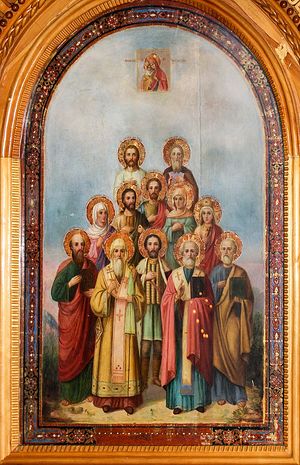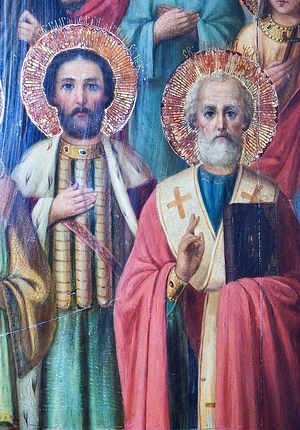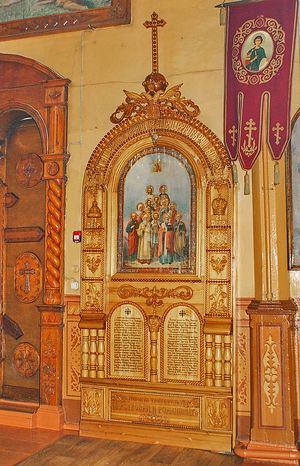 The Feodorovskaya icon of the Mother of God in commemoration of the 300th anniversary of the Romanov dynasty.
The Feodorovskaya icon of the Mother of God in commemoration of the 300th anniversary of the Romanov dynasty.
The second icon closely linked to the imperial family is called the Reigning icon of the Mother of God which was discovered on March 2, 1917, in Kolomenskoye village near Moscow (now a district within Moscow). On the same day St. Nicholas II had to abdicate the throne (for himself and his son, Tsarevich Alexei) in favor of his brother, Grand Duke Mikhail Alexandrovich. As it was in defiance of the laws of the Russian Empire, the tsar’s abdication for both himself and his son at the same time was illegitimate. Nicholas II well understood it as he knew much about the law of succession to the throne. Grand Duke Mikhail Alexandrovich could not become a tsar according to the Russian Empire’s laws anyway as he had entered into a morganatic marriage several months before the 300th anniversary of the House of Romanov (and that was scandalous news at that time). St. Nicholas took the news of Duke Mikhail’s marriage with his colleague’s ex-wife very badly as he believed that any representative of the House of Romanov should be guided by the high sense of duty and obligation to his country in everything.
Officers and cadet revolutionaries who were forcing the emperor to abdicate in favor of Duke Mikhail perfectly well knew that they were proposing an illegitimate ruler. Perhaps for this reason Nicholas II agreed with the wording of the illegal abdication. He counted upon the reaction and support of Russian society. In spring 1917 the population gladly welcomed the February Revolution and remained indifferent to the news that the throne was vacant. The discovery of the Reigning icon on the day of the tsar’s abdication was interpreted by the faithful and supporters of the monarchy as a sign that from the earthly kings the power was thus transferred to the Heavenly Queen and Her Divine Son.
After long years of militant atheism, in the Altai the third icon connected with the imperial house was discovered. The story of its finding is complex, and resembles an unusual, tangled plot of a tragic story with a happy ending.
In 1972, two local artists Vladislav Vladimirovich Tikhonov and Mikhail Prokopyevich Maneyev were travelling across the Altai (a territory in southwestern Siberia). M. Maneyev was famous for painting with the brush gripped firmly between his teeth as he had no arms. Both artists had fought in the Second World War; they were great toilers and enthusiasts. As they were visiting an art school in the Altai village of Kolyvan where Soviet attributes were displayed they spotted a table of an unusual shape. V. Tikhonov was so curious to learn what kind of a table it was that he looked under the table top and to his amazement saw images of saints there. The icon had apparently been used for making a table top during the era of atheism, which was a common thing of the age. Large icons then were often used for making tabletops, doors, and platforms for cattle; in short, they were profaned. In this case using the icon as a tabletop saved it from complete destruction. With the consent of the school principal the artists took the icon with them as representing significant artistic value and transferred it to the local history museum of the town of Rubtsovsk in the Altai territory—it was the largest center of agricultural engineering in the USSR. The Church of the Holy Archangel Michael, built in the town in 1906 by the enterprising peasant-settler Mikhail Alexeevich Rubtsov, miraculously survived.
In order to move from the surroundings of Samara on the Volga River to Altai and found a settlement there, Mikhail Rubtsov needed to get permission from the tsar himself. The fact is that before the Revolution the lands in Altai had belonged to the royal family (the so-called “cabinet lands”). Siberia was a personal possession of the tsars of the Romanov dynasty. Siberia, along with the Transbaikal territory, which belonged to the imperial family before the Revolution, yielded revenue of three to four million rubles that were managed from St. Petersburg by a special cabinet (ministry) near the Anichkov Palace. All decisions concerning these lands, their population, and economy were made with the consent of the sovereign himself.
The icon found by the artists lay for two more decades forgotten in the storerooms of the local history museum of Rubtsovsk, and nobody was concerned about its history or name. A new epoch came, the Soviet Union ceased to exist; people disappointed with the failure of Communism turned to their historical and spiritual origins with hope. In 1992 it occurred to a staff worker of the local history museum Elena Vladimirovna Bychkova to arrange an art composition, “Return to our roots”, dedicated to the town’s centenary. The center of the composition was the icon from the Kolyvan village which depicted the Mother of God with twelve saints. The icon was not yet restored at the time, but nevertheless the noble images of saints, the splendor and simplicity of the image, the pure colors, and its incomparable inner power attracted peoples’ attention. The faithful were drawn to it—they started flocking to the museum and reading akathists in front of the icon. At that time nobody could figure out why the twelve selected saints were depicted on the icon together. Several attempts were made to photograph the icon but each time unsuccessfully. A spokesman of the Mestnoye Vremya (“Local Time”) newspaper, who managed to take many pictures of the icon, was very disappointed when he discover that the film was ruined without any apparent cause. At length the icon was photographed successfully, and from that time on E. Bychkova always kept a small photo with a blurred image of the icon with her. She resolved to learn the history of this icon and find out its name. She took the photograph with her and showed it to all kinds of specialists, hoping to get some information about the holy image. Thus she visited many cities and towns, including Moscow and St. Petersburg, with the icon. The woman made an inquiry to the Church Art Museum of the Holy Trinity St. Sergius Lavra concerning the history of this icon, but all in vain—nobody was able to help her. And only by a happy incident did she find the answer. In the city of Barnaul (the administrative center of the Altai territory) Priest Constantine Metelnitsky saw this icon’s photograph. He said he had read an article about this icon in one pre-revolutionary journal. Fr. Constantine showed Bychkova a journal from his personal family archive—Russky Palomnik (“The Russian Pilgrim”) of 1913, issue no. 27, which contained a detailed description, a photograph and the history of this icon.
Thanks to the article from Russian Pilgrim the following facts became known. Numerous solemn events were held in 1913 to mark the 300th anniversary of the ruling dynasty of Romanov. As part of the celebrations it was decided to paint a commemorative icon, which was called Feodorovskaya in honor of the 300th anniversary of the House of Romanov. The creation of this icon was accomplished with the consent and the personal participation of Tsar Nicholas II, as was written in the Peterburgskaya Gazeta newspaper: “On November 12, 1912, His Majesty the Emperor, according to the report by the Minister of Internal Affairs, most graciously deigned to approve the project of an icon in commemoration of the 300th anniversary of the House of Romanov, in a decorated icon case (or kiot), to be painted in the Russian style… and to be named, ‘the icon in honor of the 300th anniversary of reign of the House of Romanov’.” The Feodorovskaya Mother of God is depicted on the icon as soaring in heaven, while below, on the ground, are the twelve saints—the patrons of all Russian sovereigns of the Romanov House—concentrated in prayer and in blue radiance.
The saints are as follows: St. Michael Maleinos (the patron-saint of Mikhail Feodorovich, the first tsar of the Romanov dynasty); St. Alexis, the Man of God (the patron of Tsar Alexei Mikhailovich); Greatmartyr Theodore Stratelates (the patron of Tsar Theodore Alexeevich); St. John the Baptist (of Tsars John IV and John V); Righteous Elizabeth (of the Empress Elizaveta Petrovna); St. Anna the Prophetess (of the Empresses Anna Ioannovna and Anna Leopoldovna); Greatmartyr Catherine (of the Empresses Catherine I and Catherine II); Paul the Apostle (of Emperor Paul I); Peter the Apostle (of Emperors Peter I the Great, Peter II and Peter III); the Right-Believing Prince Alexander Nevsky (the patron of three Russian emperors: Alexander I, Alexander II and Alexander III); St. Nicholas the Wonder-Worker (of Emperors Nicholas I and St. Nicholas II); the Holy Hierarch Alexis, Metropolitan of Moscow (of Tsarevich Alexei Nikolaevich). There were eighteen tsars of the Romanov dynasty on the Russian throne in all, while young St. Alexei never ascended the throne, becoming a victim of godless persecutors.
As we see from the above-mentioned list, some of the saints were patrons of several Russian rulers at the same time. Thus, St. Alexander Nevsky was the patron-saint of three Russian emperors. The Feodorovskaya icon belonged to St. Alexander Nevsky himself, so through the names of three outstanding Russian emperors who had the same patron-saint the historical continuity with the Rurik dynasty was formed. The last ruler of the royal house of Rurikids was Theodore Ioannovich, son of the first Russian tsar John the Terrible. His patron-saint was Greatmartyr Theodore Stratelates; the same patron was chosen for the third Russian tsar of the Romanov dynasty—Theodore Alexeevich. The royal dynasty was a symbol of unity in the Russian history, of the Russian lands and the whole of the Russian nation. Choosing the patron-saint for a future Russian tsar rested upon the tradition so that the continuity of both the family and the heavenly patronage could be provided.
On the occasion of the 300th anniversary of the Romanov dynasty it was decided to embody the tradition of naming in honor of a chosen saint into a new iconography. The patron-saints of all Russian tsars depicted on the icon are shown as the protectors of Russia and the Russian people. The project’s author was the painter Alexander Antipov, whose rank was Admiral Colonel. All major newspapers and journals of that time wrote that it was planned to create this icon and spread its copies throughout Russia—among them were Peterburgskaya Gazeta, Tserkovnye Vedomosti, Pravitelstvenny Vestnik, and Russky Palomnik. But only Russky Palomnik published a photograph of the icon itself. It was planned to place copies of this icon not only at churches, but also in rooms of government and public institutions, at railway stations and in other public places. The icon was expected to become a symbol demonstrating the piety of Russian tsars and the continuity of their policy aimed at the welfare, education and prosperity of Russia.
On December 12, 1912, Tsar Nicholas II, in the presence of ministers and other officials, approved the draft of the icon. On December 19, the Synod issued resolution no. 11737 on spreading the icon throughout the empire. According to its description and depiction in the Russky Palomnik journal, the icon had a case (kiot) crowned with an image of the orb of Tsar Mikhail Feeodorovich Romanov with a large cross. A double-headed eagle with the coat of arms of the House of Romanov is fixed below the orb. The orb is on the upper semi-circular part of the icon case’s frame, with gilded words from the Holy Scripture on it: By me kings reign (Prov. 8:15) and The king’s heart is in the hand of the Lord (Prov. 21:1). The icon case’s laterals were adorned with pilasters. Words from the message of the 1613 Zemsky Sobor (“the Assembly of the Land”—a form of a feudal estate parliament in pre-revolutionary Russia), which elected Mikhail Feodorovich Romanov to be the first Russian tsar of the new dynasty, were in the frame on the left: “Mikhail Feodorovich Romanov-Yuriev shall be the Sovereign, Tsar, Grand Prince, and Monarch of All Russia in Vladimir, and Moscow, and Novgorod Provinces, and in the Tsardoms of Kazan, and Astrakhan, and Siberia, and in all the Great and Noble Russian Provinces, of all the prior great and glorious and right-believing Russian Sovereigns crowned by God…” On the right of the icon case there was an extract from the imperial manifesto of October 20, 1894, announcing the repose of Emperor Alexander III and the accession to the throne of St. Nicholas II: “By the mercy of God, I, Nicholas II, Emperor and Sovereign of All Russia…, declare to all our faithful subjects that in this mournful yet great hour of my ascension to our ancestors’ throne of the Russian Empire, we recall the precepts of my deceased father. Inspired by them, I make a vow before the Almighty to always have peace, prosperity and the welfare of my loyal subjects as my only aim. May the Lord the Almighty, Who deigned to call me to this great service, help me. Livadia, October 20, the year 1894 after the birth of Christ and the first year of my reign.”
It was planned to install the icon one step above the floor as a sign that the royal throne belonged to the earthly realms as well as the heavenly. So, this is the very icon that was discovered in Altai: the icon that once had been created with the approval of the Holy Passion-Bearer Tsar Nicholas II.
After the name and history of the icon had become known, the clergy of St. Michael’s Church in Rubtsovsk, by agreement of the museum director, decided to move the icon from the museum to the church. And, to the great astonishment of the museum workers, it turned out that the icon had not been properly registered at the museum, and was even not mentioned in any of its documents! There was not even a record of this icon’s arrival to the museum. For the museum it was a unique situation, and its workers were just spreading their arms in perplexity. This meant that it was possible to hand the icon over to the Church without any difficulties as an object not mentioned in the museum documents. In 2003, the icon was solemnly carried from the museum to the church in a cross procession. In 2004 it was decided to restore the lost icon case—a canopy with royal attributes. It is this covering by which the holy icon is encased to this day at the St. Michael’s Church, where its parishioners deeply venerate it as a miracle-working shrine. Elena Bychkova, a former staff worker of the Rubtsovsk local history museum who now works at the Diocese of Rubtsovsk, attributes her conversion to the faith to the influence of this holy icon.
The church workers applied great efforts to find out whether there was another such icon in Russia. At last after a long search they found one more copy at the Holy Trinity Church in the town of Vsevolozhsk near St. Petersburg. The second icon was also without an icon case, and Vsevolozhsk church workers were not aware of its history. It can be said that at the present time the faithful know of only two icons of this kind in existence in Russia. Both of them are remarkable for their high quality of image which means that they were painted in the capital (then St. Petersburg). Only masters of the most famous “artels” (pre-revolutionary Russian cooperative associations of craftsmen living and working together) in St. Petersburg were commissioned to paint royal icons. A great number of such icons were created in 1913 but they were among the first victims of the Revolution. Revolutionaries hated all holy objects, but this icon was especially hated as a symbol of sovereignty. In the period of the Revolution and in the subsequent era of Soviet achievements such shrines had no chance of survival, excepting special cases, such as museum exhibits. That is why the existence of this royal icon was not known until very recently.
Before the centenary of the Russian Revolution, representatives of the Diocese of Rubtsovsk decided to spread information on the royal icon and its miraculous discovery. At the request of the Orthodox Christians living in Altai, the author of this article is very happy to make the foregoing facts public.



